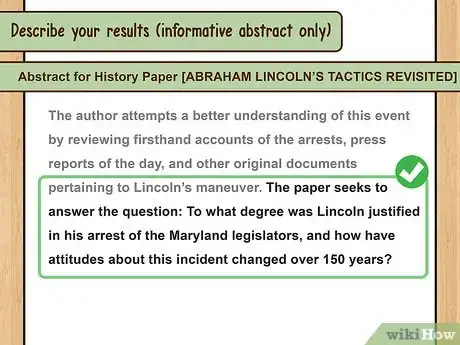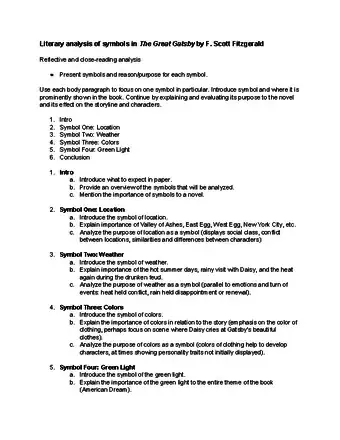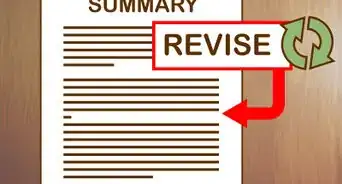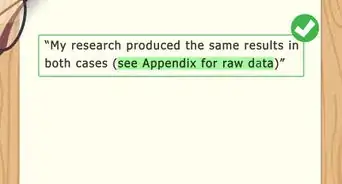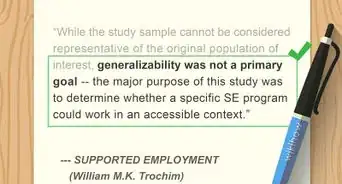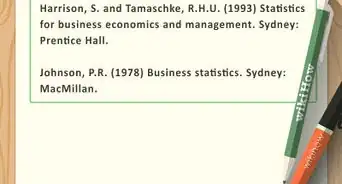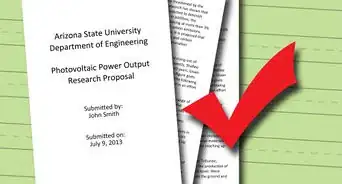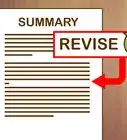This article was co-authored by Megan Morgan, PhD. Megan Morgan is a Graduate Program Academic Advisor in the School of Public & International Affairs at the University of Georgia. She earned her PhD in English from the University of Georgia in 2015.
There are 11 references cited in this article, which can be found at the bottom of the page.
wikiHow marks an article as reader-approved once it receives enough positive feedback. This article received 59 testimonials and 86% of readers who voted found it helpful, earning it our reader-approved status.
This article has been viewed 4,867,542 times.
If you need to write an abstract for an academic or scientific paper, don't panic! Your abstract is simply a short, stand-alone summary of the work or paper that others can use as an overview.[1] An abstract describes what you do in your essay, whether it’s a scientific experiment or a literary analysis paper. It should help your reader understand the paper and help people searching for this paper decide whether it suits their purposes prior to reading. To write an abstract, finish your paper first, then type a summary that identifies the purpose, problem, methods, results, and conclusion of your work. After you get the details down, all that's left is to format it correctly. Since an abstract is only a summary of the work you've already done, it's easy to accomplish!
Steps
Getting Your Abstract Started
-
1Write your paper first. Even though an abstract goes at the beginning of the work, it acts as a summary of your entire paper. Rather than introducing your topic, it will be an overview of everything you write about in your paper. Save writing your abstract for last, after you have already finished your paper.
- A thesis and an abstract are entirely different things. The thesis of a paper introduces the main idea or question, while the abstract works to review the entirety of the paper, including the methods and results.
- Even if you think that you know what your paper is going to be about, always save the abstract for last. You will be able to give a much more accurate summary if you do just that - summarize what you've already written.
-
2Review and understand any requirements for writing your abstract. The paper you’re writing probably has specific guidelines and requirements, whether it’s for publication in a journal, submission in a class, or part of a work project. Before you start writing, refer to the rubric or guidelines you were presented with to identify important issues to keep in mind.
- Is there a maximum or minimum length?
- Are there style requirements?
- Are you writing for an instructor or a publication?
Advertisement -
3Consider your audience. Abstracts are written to help readers find your work. For example, in scientific journals, abstracts allow readers to quickly decide whether the research discussed is relevant to their own interests. Abstracts also help your readers get at your main argument quickly. Keep the needs of your readers in mind as you write the abstract.[2]
- Will other academics in your field read this abstract?
- Should it be accessible to a lay reader or somebody from another field?
-
4Determine the type of abstract you must write. Although all abstracts accomplish essentially the same goal, there are two primary styles of abstract: descriptive and informative. You may have been assigned a specific style, but if you weren’t, you will have to determine which is right for you. Typically, informative abstracts are used for much longer and technical research while descriptive abstracts are best for shorter papers.[3]
- Descriptive abstracts explain the purpose, goal, and methods of your research but leave out the results section. These are typically only 100-200 words.
- Informative abstracts are like a condensed version of your paper, giving an overview of everything in your research including the results. These are much longer than descriptive abstracts, and can be anywhere from a single paragraph to a whole page long.[4]
- The basic information included in both styles of abstract is the same, with the main difference being that the results are only included in an informative abstract, and an informative abstract is much longer than a descriptive one.
- A critical abstract is not often used, but it may be required in some courses. A critical abstract accomplishes the same goals as the other types of abstract, but will also relate the study or work being discussed to the writer’s own research. It may critique the research design or methods.[5]
Writing Your Abstract
-
1Identify your purpose. You're writing about a correlation between lack of lunches in schools and poor grades. So what? Why does this matter? The reader wants to know why your research is important, and what the purpose of it is. Start off your descriptive abstract by considering the following questions:
- Why did you decide to do this study or project?
- How did you conduct your research?
- What did you find?
- Why is this research and your findings important?
- Why should someone read your entire essay?
-
2Explain the problem at hand. Abstracts state the “problem” behind your work. Think of this as the specific issue that your research or project addresses. You can sometimes combine the problem with your motivation, but it is best to be clear and separate the two.
- What problem is your research trying to better understand or solve?
- What is the scope of your study - a general problem, or something specific?
- What is your main claim or argument?
-
3Explain your methods. Motivation - check. Problem - check. Methods? Now is the part where you give an overview of how you accomplished your study. If you did your own work, include a description of it here. If you reviewed the work of others, it can be briefly explained.[6]
- Discuss your own research including the variables and your approach.
- Describe the evidence you have to support your claim
- Give an overview of your most important sources.
-
4Describe your results (informative abstract only). This is where you begin to differentiate your abstract between a descriptive and an informative abstract. In an informative abstract, you will be asked to provide the results of your study. What is it that you found?
- What answer did you reach from your research or study?
- Was your hypothesis or argument supported?
- What are the general findings?
-
5Give your conclusion. This should finish up your summary and give closure to your abstract. In it, address the meaning of your findings as well as the importance of your overall paper. This format of having a conclusion can be used in both descriptive and informative abstracts, but you will only address the following questions in an informative abstract.[7]
- What are the implications of your work?
- Are your results general or very specific?
Formatting Your Abstract
-
1Keep it in order. There are specific questions your abstract must provide answers for, but the answers must be kept in order as well. Ideally, it should mimic the overall format of your essay, with a general ‘introduction, ‘body,’ and ‘conclusion.’
- Many journals have specific style guides for abstracts. If you’ve been given a set of rules or guidelines, follow them to the letter.[8]
-
2Provide helpful information. Unlike a topic paragraph, which may be intentionally vague, an abstract should provide a helpful explanation of your paper and your research. Word your abstract so that the reader knows exactly what you’re talking about, and isn’t left hanging with ambiguous references or phrases.
- Avoid using direct acronyms or abbreviations in the abstract, as these will need to be explained in order to make sense to the reader. That uses up precious writing room, and should generally be avoided.
- If your topic is about something well-known enough, you can reference the names of people or places that your paper focuses on.
- Don’t include tables, figures, sources, or long quotations in your abstract. These take up too much room and usually aren’t what your readers want from an abstract anyway.[9]
-
3Write it from scratch. Your abstract is a summary, yes, but it should be written completely separate from your paper. Don't copy and paste direct quotes from yourself, and avoid simply paraphrasing your own sentences from elsewhere in your writing. Write your abstract using completely new vocabulary and phrases to keep it interesting and redundancy-free.
-
4Use key phrases and words. If your abstract is to be published in a journal, you want people to be able to find it easily. In order to do so, readers will search for certain queries on online databases in hopes that papers, like yours, will show up. Try to use 5-10 important words or phrases key to your research in your abstract.[10]
- For example, if you’re writing a paper on the cultural differences in perceptions of schizophrenia, be sure to use words like “schizophrenia,” “cross-cultural,” “culture-bound,” “mental illness,” and “societal acceptance.” These might be search terms people use when looking for a paper on your subject.
-
5Use real information. You want to draw people in with your abstract; it is the hook that will encourage them to continue reading your paper. However, do not reference ideas or studies that you don’t include in your paper in order to do this. Citing material that you don’t use in your work will mislead readers and ultimately lower your viewership.
-
6Avoid being too specific. An abstract is a summary, and as such should not refer to specific points of your research other than possibly names or locations. You should not need to explain or define any terms in your abstract, a reference is all that is needed. Avoid being too explicit in your summary and stick to a very broad overview of your work.[11]
- Make sure to avoid jargon. This specialized vocabulary may not be understood by general readers in your area and can cause confusion.[12]
-
7Be sure to do basic revisions. The abstract is a piece of writing that, like any other, should be revised before being completed. Check it over for grammatical and spelling errors and make sure it is formatted properly.
-
8Get feedback from someone. Having someone else read your abstract is a great way for you to know whether you’ve summarized your research well. Try to find someone who doesn’t know everything about your project. Ask him or her to read your abstract and then tell you what s/he understood from it. This will let you know whether you’ve adequately communicated your key points in a clear manner.
- Consulting with your professor, a colleague in your field, or a tutor or writing center consultant can be very helpful. If you have these resources available to you, use them!
- Asking for assistance can also let you know about any conventions in your field. For example, it is very common to use the passive voice (“experiments were performed”) in the sciences. However, in the humanities active voice is usually preferred.
Sample Abstracts and Outline
Community Q&A
-
QuestionWhat’s the best way to write an abstract for a presentation?
 wikiHow Staff EditorThis answer was written by one of our trained team of researchers who validated it for accuracy and comprehensiveness.
wikiHow Staff EditorThis answer was written by one of our trained team of researchers who validated it for accuracy and comprehensiveness.
Staff Answer wikiHow Staff EditorStaff AnswerAn abstract for a presentation is much like any other abstract. In 1-2 sentences, briefly introduce the focus and purpose of your presentation, then write a couple sentences about your methods and results. Finish up with a brief statement of your conclusions. Try to keep it to 250 words or fewer.
wikiHow Staff EditorStaff AnswerAn abstract for a presentation is much like any other abstract. In 1-2 sentences, briefly introduce the focus and purpose of your presentation, then write a couple sentences about your methods and results. Finish up with a brief statement of your conclusions. Try to keep it to 250 words or fewer. -
QuestionHow do you write an MLA style abstract?
 wikiHow Staff EditorThis answer was written by one of our trained team of researchers who validated it for accuracy and comprehensiveness.
wikiHow Staff EditorThis answer was written by one of our trained team of researchers who validated it for accuracy and comprehensiveness.
Staff Answer wikiHow Staff EditorStaff AnswerAn MLA abstract should be about 150-250 words long. Briefly introduce the aims and objectives of your work and end with 1-2 sentences discussing your conclusions. The actual formatting will depend on the specific assignment or publication, but in general the abstract should go after the title and before the main body of the work.
wikiHow Staff EditorStaff AnswerAn MLA abstract should be about 150-250 words long. Briefly introduce the aims and objectives of your work and end with 1-2 sentences discussing your conclusions. The actual formatting will depend on the specific assignment or publication, but in general the abstract should go after the title and before the main body of the work. -
QuestionHow do I write an abstract in APA format?
 wikiHow Staff EditorThis answer was written by one of our trained team of researchers who validated it for accuracy and comprehensiveness.
wikiHow Staff EditorThis answer was written by one of our trained team of researchers who validated it for accuracy and comprehensiveness.
Staff Answer wikiHow Staff EditorStaff AnswerAn APA abstract should be 1 paragraph and approximately 250 words long. Put the title of your paper at the top of the page, aligned left in all caps, and the page number on the right. On the first line, write “Abstract” and center it over the body of the text. Write your abstract under that as a single paragraph with no indentations. If you like, you can add a list of keywords relating to the content of your paper at the bottom of the abstract.
wikiHow Staff EditorStaff AnswerAn APA abstract should be 1 paragraph and approximately 250 words long. Put the title of your paper at the top of the page, aligned left in all caps, and the page number on the right. On the first line, write “Abstract” and center it over the body of the text. Write your abstract under that as a single paragraph with no indentations. If you like, you can add a list of keywords relating to the content of your paper at the bottom of the abstract.
References
- ↑ http://writingcenter.unc.edu/handouts/abstracts/
- ↑ http://writing.wisc.edu/Handbook/presentations_abstracts_examples.html
- ↑ http://writingcenter.unc.edu/handouts/abstracts/
- ↑ http://owl.english.purdue.edu/owl/resource/656/1/
- ↑ http://writingcenter.unc.edu/handouts/abstracts/
- ↑ https://www.ece.cmu.edu/~koopman/essays/abstract.html
- ↑ https://owl.english.purdue.edu/owl/resource/656/1/
- ↑ http://www.ncbi.nlm.nih.gov/pmc/articles/PMC3136027/
- ↑ http://writing.wisc.edu/Handbook/presentations_abstracts.html
About This Article
To write an abstract, start with a short paragraph that explains the purpose of your paper and what it's about. Then, write a paragraph explaining any arguments or claims you make in your paper. Follow that with a third paragraph that details the research methods you used and any evidence you found for your claims. Finally, conclude your abstract with a brief section that tells readers why your findings are important. To learn how to properly format your abstract, read the article!







